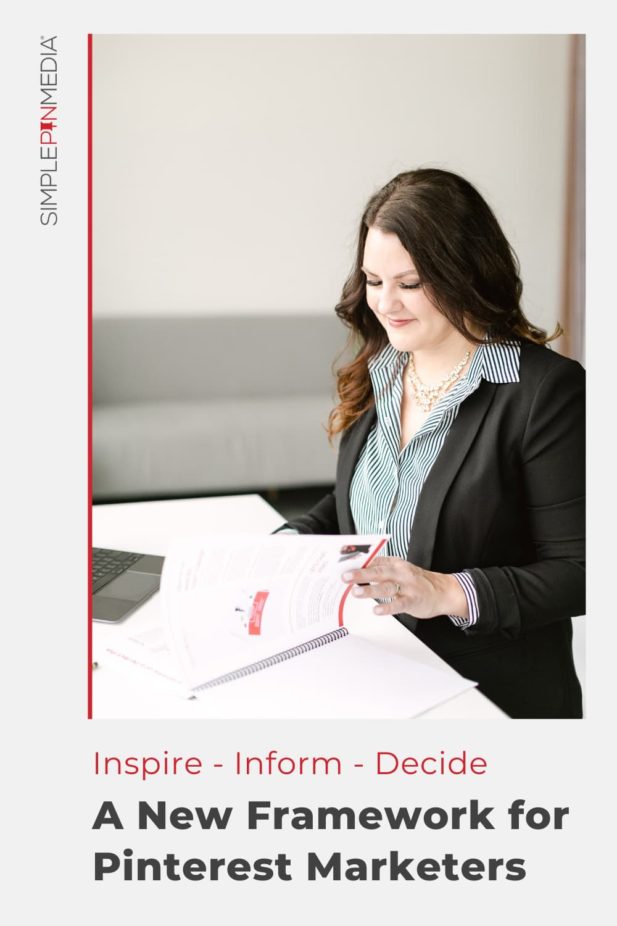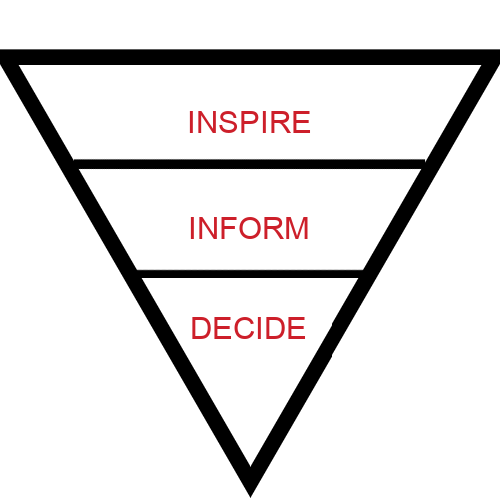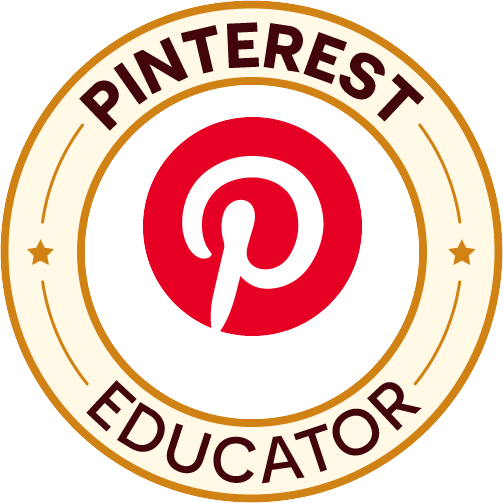For a long time now I’ve been struggling to come up with a Pinterest framework that tells us how we learn about our audience. How do we discover where they are in their buyer’s journey or what led them to your site or product? Today we’re talking about a new framework we are using here at Simple Pin Media that guides how we gather this information.
Now let’s get back to today’s episode.
Pinterest Framework Background
For the past couple of years, I’ve had this vision rolling around in my head and I just couldn’t put it into words. Today we are talking about how I found those words, the importance of truly knowing where your audience is at now and what their needs are, and finally, we will talk about how to inspire, inform, and help them make a decision!
Simple Pin Media is not a plug-and-play Pinterest management service. We are a high-touch management service. Our goal is to really know you, your brand, and your goals.
That high-touch philosophy starts way back at the step where you fill out that very first form on our website, even before you sign up for our services.
Our contact form is intentionally long because we want to really understand you through the information you provide. We want to serve you well and that comes from knowing that you are a good fit for us and we are a good fit for you.
Once we receive a form, potential clients participate in a discovery call that helps us get to know each other better. Once we know we are a good fit for each other, we determine the best service package for you.
So I kept thinking about that initial entry point as it relates to you – our clients.
How do we help you understand where you’re really connecting with your customers?
This is at the core of what we do here at Simple Pin.
We decided to interview a few of our current e-commerce clients.
We know that serving an e-commerce business owner is much different than a blogger/content creator or a person offering services/coaching. We wanted to learn from our e-commerce clients what their biggest pain point was and how we can meet that need.
We interviewed Kirsten, from Julep Tile Company. They sell beautiful handmade tiles.
We asked Kirsten what she needs from us as it pertains to getting more sales from Pinterest. What she said really hit home.
I don’t need you guys to get them to my checkout page. This is such a big purchase, I need to get them on the phone so I can help them decide. So I don’t need you to help them decide. When I’m on the phone I hear that they found me on Pinterest. — Kirsten
Kirsten explicitly stated that she needed our help to inspire potential clients. She can talk her clients through the process of choosing the right tile if we help get them to her website. From there, she can personally get them to the purchase decision.
All of a sudden it clicked!
The decision to purchase doesn’t happen on Pinterest, but the inspiration does.
I immediately drew this upside-down triangle and the basic Pinterest framework I had been desperately trying to create over these past few years finally came to fruition.
Since that day, it has developed into a complete, detailed framework that we have implemented within our company.
Rolling Out New Ideas to The Team: The Process I Recommend
My meeting with Kirsten helped me realize this framework vision had to be taught and incorporated team-wide at here Simple Pin. We needed everyone on the team to understand how we help our clients figure out where they are in the Pinterest framework and how we can best serve them as they try to reach their potential customers.
I want to pause briefly here to share a piece of important advice to small business owners who lead a team.
When you have an idea you want to implement company-wide, you need to sit with it for a while by yourself first. Next, talk to a few people in your leadership team, allowing them to give feedback, ask questions, and gain understanding.
Then you can go through this same process with the whole team so they can give you feedback and ask questions as well. All of this needs to happen for new ideas to be successfully implemented company-wide.
Related: Training a Pinterest Marketing Team
We’ve gone through this refinement process rolling out the new framework here at Simple Pin. Now every member of the team understands that success with our clients starts way back at the point of the discovery call.
Our New Pinterest Framework
So what is the Pinterest framework and how do you put it into play in your business?
As mentioned before, the framework consists three stages:
- Inspire
- Inform
- Decide.
Each stage has four points of qualification:
- What actions do we want the Pinner to take on the specific pins?
- What analytics are you going to use to track said action or goal?
- What’s needed to achieve that goal?
- What type of businesses would fall into that category?
The INSPIRE Stage
This is the stage I believe we find most Pinners on Pinterest. It’s the biggest group at the top of the inverted triangle. They come to Pinterest to be inspired.
The actions we want them to take is:
- save to a Pinterest board for later
- click to read more.
The Pinterest analytics or markers that show us people have had a touchpoint with a particular pin are:
- saves
- clicks
- close-ups
- impressions
- views on videos and story pins (now called “Idea pins”)
To be successful in getting Pinners to take the desired action at this stage you need:
- great Pinterest images
- great Pinterest keywords
- story pins
- video pins
The type of business owner that falls in the Inspire stage will include:
- a blogger who really wants to make affiliate income
- someone who is heavily focused on Instagram and wants to build brand awareness
- someone who wants to build engagement and be seen in many places
The INFORM Stage
This is the middle of the triangle where the Pinner has been inspired and they want to know more. At this stage, they are going to stick around. You want to deliver a ton of value.
The actions we want the Pinner to take in this stage include:
- read a blog post with the longer-term intention
- sign up for your email list
- read product reviews.
Analytics that matter most in this stage are:
- clicks to your website
- engagement
- bounce rate
- possibly UTM tracking.
(UTM tracking is a little more sophisticated and might be more important for the next stage (Decide), but it’s kind of teetering on the edge here).
To successfully inform your audience you need:
- great images
- great keywords
- a blog for ecommerce clients
- sales copy encouraging them to “join”
- video pins
- story pins
This stage is your front door. For e-commerce it’s definitely going to be a blog.
Now I know those of you who have products are saying,
“Seriously Kate? You keep harping on a Blog.”
If you haven’t listened to our last podcast with Laurelbox, you seriously need to go listen.
At the end of that episode, we learned that the owners attribute much of their success to the fact that they really understood their Pinterest traffic. They knew how targeted pins on Pinterest helped them inspire potential clients. It helped get them in the door where they were able to inform the Pinner and then lead them to a purchase decision.
Kirsten at Julep Tile had the same experience. She knew if she could inform people about how to choose tiles through reading her blog post, they would take the next action (i.e., making a decision). They wouldn’t necessarily buy all the time but they were becoming hooked on this particular brand.
Story pins work well in this stage. I’m a big fan of story pins. I know people throw shade because they don’t allow you to include a link, but I think they’re going to be a super cool tool for Pinterest marketers in the coming months and years.
Even without a link, story pins inspire people to visit your Pinterest profile to see what you have to offer.
Businesses that should really double down to inform the Pinterest user include:
- e-commerce both digital and physical products
- content creators with a huge email list focus
- course creators.
The DECIDE Stage
This is the last stage that Pinterest users move through and it is the hardest to achieve through Pinterest marketing. That’s why it’s at the bottom of the upside-down triangle.
Pinterest users represent super cold traffic. Most of the time, they are three to six months away from making a purchasing decision. They’re going to gather 25 pins before they take an action on one of them.
The potential actions you want Pinners in this stage to take include:
- signing up for your list
- buying your product on sight
- signing up for a call with you
- filling out a form
Pinterest is trying to make the journey from inspiration to decision much shorter with their shop integrations. I still think they have a long way to go, but I believe they’re going to get better at it as we go along.
Here’s a caution for focusing on the DECIDE stage.
Eight years of working with clients have demonstrated to me that there are a lot of clients who will say they are at the Decide stage. They want Pinners to buy (Decide).
However, if you haven’t invested in the Inspire or Inform stages with your clients, you haven’t built any authority with them.
Let’s take the example of Julep Tile.
If Kirsten came to me and said I want you to get them to buy tile. I’d say you have to inspire them first. She might say I don’t want to inspire them. I don’t even want to inform them. I just want them to decide.
Without that investment in the Inspire or Inform stages, you’re going to have to work much harder in your Pinterest marketing efforts. On Pinterest, you haven’t built up any authority as an expert yet.
If Decide is your only goal on Pinterest, you’re going to have to be way more patient. You’re not an Amazon or a grocery store where you can get them to decide right away because they come in already knowing what they want.
The analytics necessary for the Decide stage is critical and detailed. Key indicators include:
- opt-in rates for emails
- open rates
- click rates on emails
- cart checkouts
- customer acquisition cost
- promoted Pin conversion metrics.
If you listen to our last episode with Laurelbox, you’ll learn that they knew the importance of their analytics. Knowing this data really empowered them to make great decisions as a company.
To be successful on Pinterest at the Decide stage you need:
- great keywords and images
- UTM codes
- effective sales copy
- a strong digital marketing funnel
If you’re not good at writing really compelling text for your pin images or really great copy that hooks your audience once they land on your page, you might want to consider hiring this out to a professional copywriter.
It’s that important!
Businesses that might be in the Decide stage include:
- an e-commerce seller who is very numbers-driven – blog or no blog (I still HIGHLY recommend a blog!)
- e-commerce business with a higher ticket item product – being aware that the pathway to get the Pinner to decide might not be on Pinterest.
So that’s the new Simple Pin Pinterest Framework in a nutshell.
Inspire – Inform – Decide Recap
Pinners move through three stages: Inspire, Inform, and Decide.
Inspire is what happens every single day on Pinterest. This is why the platform was created. Pinterest loves to inspire people to dream and complete projects.
Once inspired, Pinners then take steps to become more Informed. They want to know more. They’re willing to read long-form articles, especially if it hits them right where they’re at.
Finally, we have the Decide stage. Pinners are ready to take action– to purchase that idea they’ve saved to their boards. This is where we want to really dig in and discover when and why they’re making the purchase.
As we work with all of our clients, we believe it is important to help them understand where they are meeting their clients within this framework for Pinterest marketing.
If you know where you are meeting the Pinner as they come to Pinterest, you’re going to shine so much brighter on the platform. You’ll be better able to focus your efforts on the right things and be able to meet your audience in the right place.
I’m not going to lie.
Over the years, I have dogged the Pinterest impressions stat a lot. This framework gave me the freedom to realize that impressions and views can be important if you are in the Inspire stage.
However, impressions aren’t really important to the person who’s just looking for Pinners to make a decision. They want something more concrete.
I hope that learning about this new Pinterest marketing framework allows you to take away some ideas that help you become aware of where you’re at in your Pinterest marketing. Most of all, I hope it gives you the freedom to lean into exactly where you’re at and know where you’ll be able to meet your Pinners most effectively.
When it comes to marketing, I still love Pinterest!
It’s been eight years, (five years of the podcast) and I still love talking about Pinterest for one reason:
Pinterest is a great, undervalued platform for introducing a lot of people to your product.
I believe our framework helps you reach the right Pinners for your business in the best possible way. I’m not necessarily talking about reaching a million viewers. I’m talking about reaching the people you need. The ones who will purchase your product.
After all, getting a hundred people to your website and having 15 people purchase the product is better than getting a thousand people to your website and only one person purchasing your product. I want the 15 for you that are going to say yes to what you have to offer.
I would love to know where you believe your people are within this framework. Are you hitting them within Inspire, Inform or Decide stage on Pinterest?
If you need help identifying where each of these areas shows up in your own business, you can book a consultation with our team or allow us the opportunity to manage your Pinterest account for you.
For Further Listening/Reading:
- How Pinterest’s Goals for 2021 Should be Influencing Your Marketing Strategy
- Pinterest KPIs: How to Measure Success
- Smart Ways to Master Pinterest Marketing in 2021
FREE Download - Getting Started with KPIs Guide

Learn how to track Key Performance Indicators to measure your business success. Download our FREE printable Getting Started with KPIs Guide











